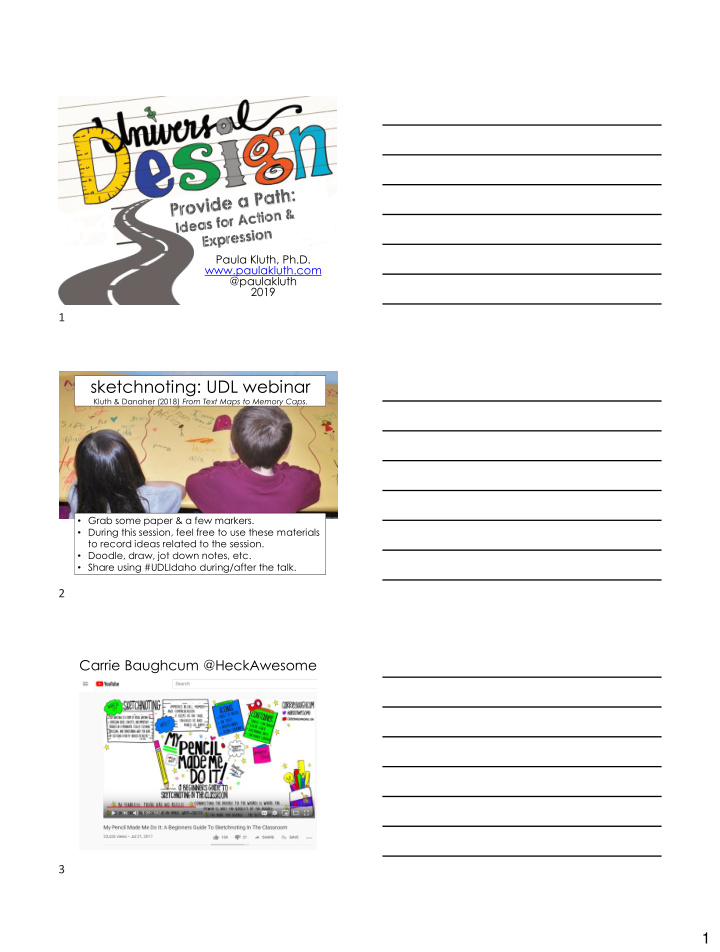



Powerful Ways to Support All Students in the Diverse Classroom Paula Kluth, Ph.D. www.paulakluth.com @paulakluth 2019 1 sketchnoting: UDL webinar Kluth & Danaher (2018) From Text Maps to Memory Caps . • Grab some paper & a few markers. • During this session, feel free to use these materials to record ideas related to the session. • Doodle, draw, jot down notes, etc. • Share using #UDLIdaho during/after the talk. 2 Carrie Baughcum @HeckAwesome 3 1
“shaking up” the ways students action & express what they expression know engagement representation 4 options for expression & • communication (e.g., compose in multimedia, action & solve problems using a expression variety of strategies) options for physical • action (e.g., use of switches, add alternative keyboard) options for executive • functions (e.g., provide checklists, encourage goal setting) 5 6 2
7 8 “Alexa, what’s 3 squared?” “Alexa, what is the fact of the day?” 9 3
writing without a pencil Kluth & Danaher (2018). From Tutor Scripts to Talking Sticks. 10 classify, sort & organize Udvari-Solner & Kluth (2018). Joyful learning . Corwin Press. • Give each student a card. hyperbo le • Ask students to find other students with cards that fit into the same category. • Have each group briefly present to the rest of the class. As each category is presented, provide links, make related points, etc. • Add complexity by changing categories & the cards themselves (e.g., visuals/descriptions instead of You are a words alone). firecracker. 11 the side opposite the 90 degree angle in a right triangle 12 4
• A wider range of literacy skills & strategies to adopt/adapt for academic tasks • A wider range of background experiences to call on when reading/responding to literature • Increased opportunities for students to use assistive technology, AAC, etc. • A greater awareness of differences that exist beyond school walls (where people are rarely segregated on the basis of perceived ability) Chandler-Olcott & Kluth [2009] 13 14 • Create tools that help students with disabilities make choices and direct classroom activities. • Allow other students to use those tools as well. 15 5
16 17 tic-tac- toe boards & menu boards • add items related to IEP objectives • Involve collaborative partners 18 6
19 20 21 7
22 tools for telling stories 23 So many options for composing & sharing ideas: • spellchecks & word prediction software • text-to-speech software, human dictation, recording • calculators • manipulatives • sentence starters/sentence strips • story/concept maps & outlining tools • web applications (e.g., wikis, animation, presentation) 24 8
25 doodle notes/sketchnotes Kluth & Danaher (2010). From tutor scripts to talking sticks. Baltimore: Brookes. • coloring book creations • graffiti notes 26 If students don’t know how to represent ideas visually, provide some examples & time to practice. 27 9
• 40 participants monitored a monotonous mock telephone message for the names of people coming to a party. • Half of the group was randomly assigned to a doodling condition where they shaded printed shapes while listening to the telephone call. • The doodling group performed better on the monitoring task and recalled 29% more information on a surprise memory test. Unlike many dual task situations, doodling while working can be beneficial. Andrade, J. (2010). What does doodling do? Applied Cognitive Psychology, 24 (1), 100-106. 28 29 How can we help students monitor their own progress? 30 10
whip around: an option for expression & reflection 31 roll ‘ em Kluth, P. [2017]. UDL Daily . • In small groups, students turns rolling a die. • Each learner provides a response related to his/her roll: 1: a concept/idea learned in this unit 2: a question about this unit so far 3: a skill I’m learning/I have learned 4: a key idea in this unit 5: new vocab. word from this unit 6: something I still want to learn 32 student-created goal cards • Students need opportunities to create their own targets & goals. They also need modeling & scaffolding. • 33 11
34 Kluth, P. & Causton, J. (2016). 30 Days to the Co-Taught Classroom . 35 Provide support for working memory: Whenever working memory is not construct- relevant in a lesson, it’s important to provide internal scaffolds & external aids to keep information organized & easy to access [cast.org]: • checklists • note-taking forms & templates • prompts for categorizing & systematizing 36 12
checklists “Off the Page”: YouTube 37 protocol book Kluth, P. & Danaher, S. (2013). From Text Maps to Memory Caps . 38 39 13
www.cast.org 40 www.udldaily.com 41 Want to learn more about inclusion, collaboration & UDL? Visit me on social media or on my website… 42 14
www.youtube.com: Paula Kluth to my channel for free tips to view, post & share 43 www.paulakluth.com 44 15
Recommend
More recommend